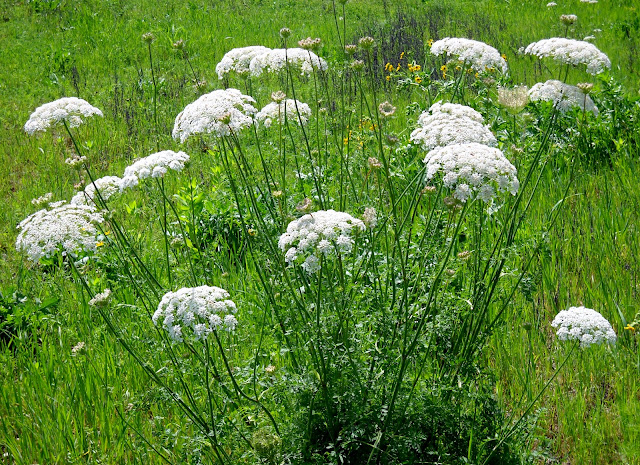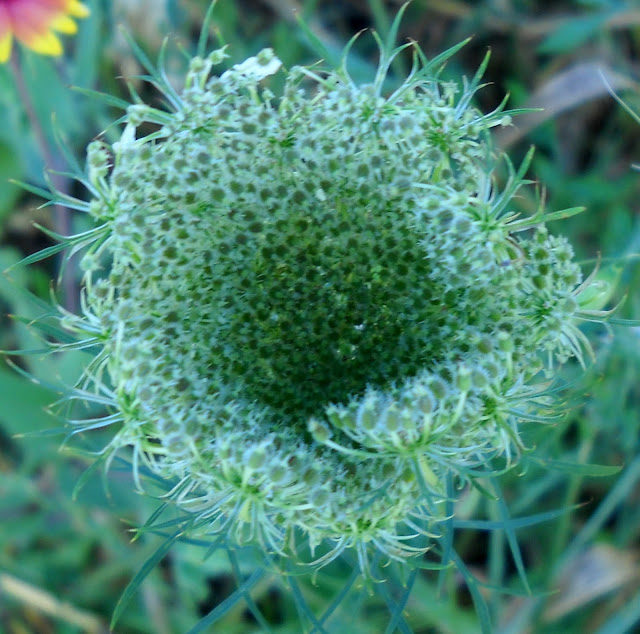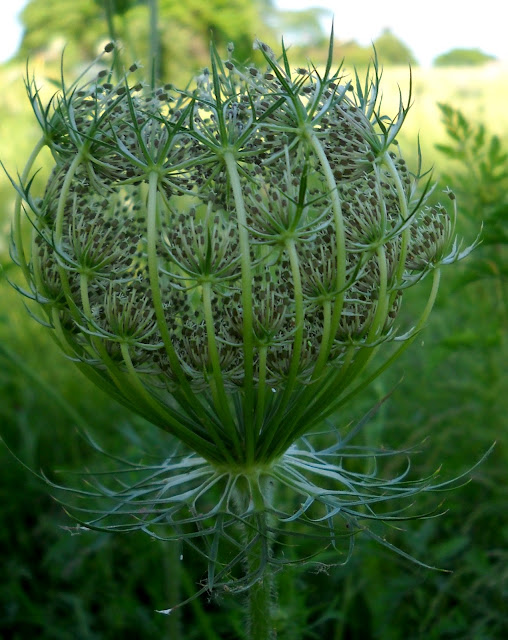Queen Anne’s
Lace (Daucus carota) at White Rock Lake, Dallas
During the
flowering period the flower head is nearly flat or slightly convex. A flower head
comprises multiple individual clusters of flowers that radiate from the stalk,
and each cluster has approximately 20 individual flowers that all originate
from a common point (an umbel).
The individual clusters of flowers all arise from a common point
The lace-like flowers of the Wild Carrot aka Queen Anne's Lace
An interesting feature of the flower is the single dark purple floret in the center of the flower (and sometimes it is blood red). Legend has it that Queen Anne’s Lace is named after Queen Anne of England, an expert lace maker. One day she pricked her finger with a needle while making lace, and a single drop of blood fell into the lace, thus the dark purple floret in the center of the flower. In reality, the function of this red or purple flower is to attract insects.
The single dark purple floret in the
center of the flower attracts insects
If you examine the lace-like flowers of the Wild Carrot closely, you will find all kinds of visiting insects. Caterpillars of the Eastern Black Swallowtail butterfly eat the leaves, and bees and other insects drink the nectar.
A honey bee visiting Queen Anne's Lace, White Rock Lake, Dallas
Daucus carota has been used for medicinal purpose for several centuries, and the root is edible. In fact, women have used the seeds from the Carrot Plant as a contraceptive, and the earliest written reference for such use dates back to a work written by Hippocrates, the father of modern medicine.
During the
flowering period the head is nearly flat or slightly convex
The flower heads also seem to become a rendezvous for insects looking for mates, and perhaps this is the plant's biggest contribution to nature.
These bugs found love on Queen Anne's Lace
Some flowers on this plant have already developed seed heads
After pollination, the umbel of the flower head begins to fold in on itself, somewhat like an umbrella that has been turned inside out, and during this process the seed head resembles a bird’s nest.
Daucus Carota is often called Bird's Nest for obvious reasons
As the seeds ripen the flower head becomes more cup-like. At the tip of nearly every tiny flower stalk is a minute ovoid fruit covered with tiny sharp bristles, and this is what has been used as a contraceptive for centuries. The seeds are clearly visible in the image below.
In its second year the plant blooms, sets seeds and
then dies.
The Wild Carrot is not native to the USA. The seeds were introduced by settlers from Europe. Regrettably, the Queen Anne's Lace is an invasive species and some dire action is required to prevent it from crowding out the indigenous flora. As can be seen below, the plant is widespread and does constitute a threat to the wildflowers of White Rock Lake.
Queen Anne's Lace is an invasive species - some dire action is
required to prevent it from crowding out the indigenous flora
required to prevent it from crowding out the indigenous flora
White Rock Lake is located in east Dallas, Texas.











QAL and Bishop's Lace are two different plants. One is invasive and the other is a native.
ReplyDelete